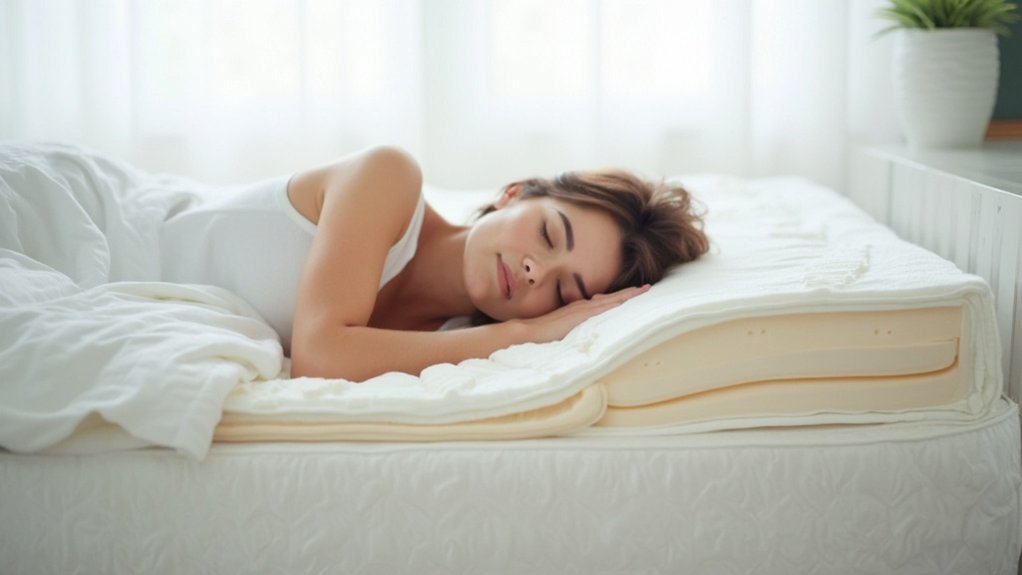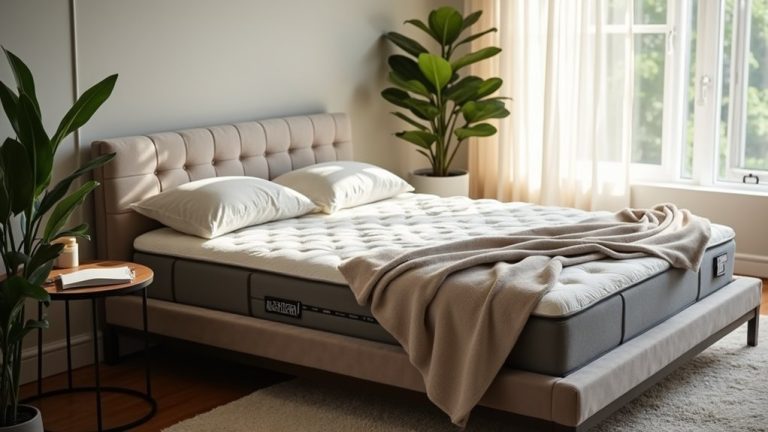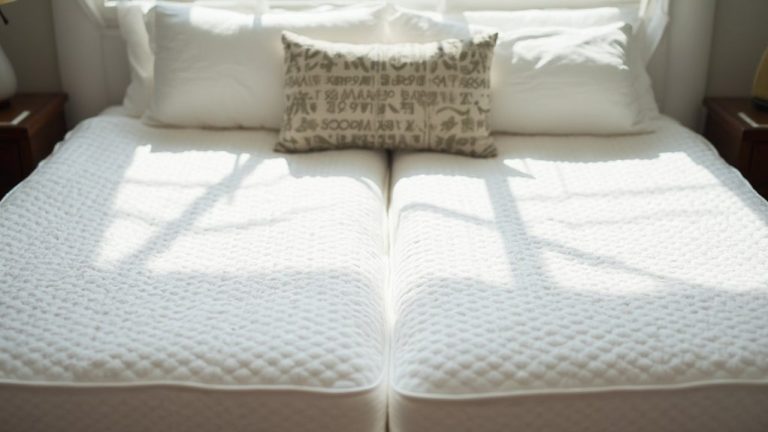What’s the Best Type of Mattress for Side Sleepers?
For side sleeping, you'll want a medium to medium-firm mattress (5-6 on the firmness scale) that combines pressure relief with proper support. Memory foam or hybrid mattresses work best, as they cushion your shoulders and hips while maintaining spinal alignment. Look for models with zoned support systems that offer softer areas for pressure points and firmer sections for core support. Temperature regulation is also essential – consider options with cooling features like gel-infused foam or breathable hybrid designs. Your weight influences ideal firmness: under 130 lbs should aim for 4-7, while 130-230 lbs need 5-7 firmness. The right combination of materials can transform your sleep quality.
Finding Your Ideal Mattress Firmness

When it comes to side sleeping, finding the right mattress firmness is essential for proper spinal alignment and pressure relief. Most side sleepers find their sweet spot with medium to medium-firm mattresses, typically in the 5-6 firmness range. Research shows that 80% of sleepers prefer mattresses in the 5-7 firmness range.
Your ideal firmness level largely depends on your weight:
- Under 130 pounds: Choose a mattress with 4-7 firmness
- 130-230 pounds: Look for 5-7 firmness
- 230-300 pounds: Target 5.5-7 firmness
- 300-350 pounds: Select 6.5-8 firmness
You'll want to avoid extremes in either direction. Mattresses below 4 on the firmness scale won't provide enough support for your spine, while those above 7 can create uncomfortable pressure points on your shoulders and hips.
To determine your ideal firmness, spend at least 10-15 minutes testing mattresses in-store. You can also reflect on past experiences with hotel mattresses or your current sleeping surface.
Consider whether you've found more comfort on softer or firmer surfaces, and adjust your selection accordingly. Remember that proper support and comfort often require finding the right balance between too soft and too firm.
Essential Materials That Work
Memory foam delivers exceptional pressure relief by conforming to your body's unique shape. You'll find it especially beneficial for supporting pressure points at your shoulders and hips, though you'll want to look for variants with cooling properties to prevent overheating. Looking at test data, mattresses like the Saatva Classic achieve perfect pressure relief scores.
Latex offers a responsive alternative that won't leave you feeling stuck. It's an excellent choice if you value durability and need a material that bounces back quickly while still providing essential pressure relief for side sleeping positions.
Hybrid mattresses combine the strengths of multiple materials to deliver extensive support. You'll benefit from the airflow of coil systems while getting the pressure relief of foam layers.
Many hybrids feature zoned support that's firmer under your lower back and softer at the shoulders.
For additional options, consider specialized poly foam hybrids. These mattresses often incorporate innovative materials like copper-infused or gel-infused foams, which enhance cooling while maintaining the support you need for proper side-sleeping alignment.
Pressure Points and Body Support
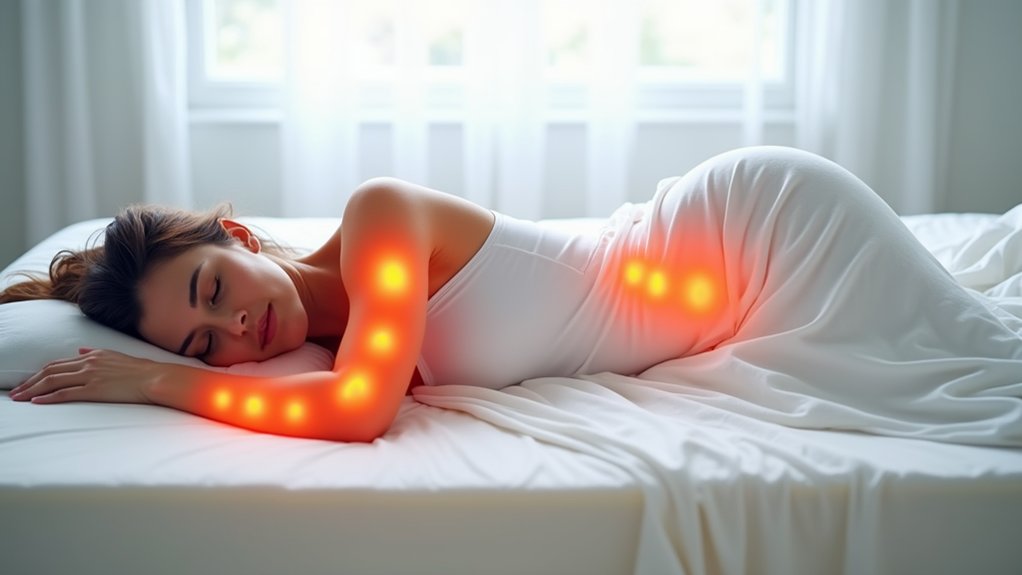
Side sleeping puts intense pressure on specific areas of your body, particularly your shoulders and hips. Without proper support, these pressure points can lead to morning soreness and disrupted sleep.
You'll need a mattress that provides targeted cushioning to these sensitive areas while maintaining proper spinal alignment.
The key is finding the right balance between comfort and support. A medium-soft to medium-firm mattress typically works best, as it allows your shoulders and hips to sink slightly while keeping your spine straight.
Look for mattresses with zoned support systems that offer softer areas under pressure points and firmer support elsewhere. Our Sleep Certified experts have thoroughly tested these systems for effectiveness.
Materials like memory foam and latex can effectively distribute your body weight and reduce pressure concentration. These materials conform to your body's curves while providing the necessary support to keep your spine aligned.
They also excel at motion isolation, which is essential if you share your bed and tend to change positions throughout the night.
To maintain the mattress's pressure-relieving properties, make sure you have a solid foundation. This prevents premature sagging that could create new pressure points and compromise spinal alignment.
Core Support Matters
While comfort layers cushion your pressure points, a mattress's core support system plays an essential role in your sleep quality. In hybrid mattresses, pocketed coils form the foundation that prevents excessive sinkage and maintains proper spinal alignment while you sleep on your side.
The construction of these coils matters greatly for your comfort. You'll find that individually wrapped coils work independently, providing targeted support where you need it most. They'll respond to your body's curves while reducing motion transfer, which is especially beneficial if you share your bed. Most hybrid mattresses have a 6-8 year lifespan with proper care and maintenance.
When you're shopping for a side-sleeping mattress, look for models with zoned support systems. These feature varying coil firmness levels – softer under your shoulders and hips, firmer in your lumbar region. This design helps maintain your spine's natural curve while sleeping.
The integration of coils with comfort layers creates an ideal balance. You'll get the pressure relief from memory foam or latex on top, while the coils beneath provide the essential bounce and responsiveness you need to change positions easily.
Plus, reinforced perimeter coils guarantee you can use the entire surface of your mattress without feeling like you'll roll off.
Temperature Control Features
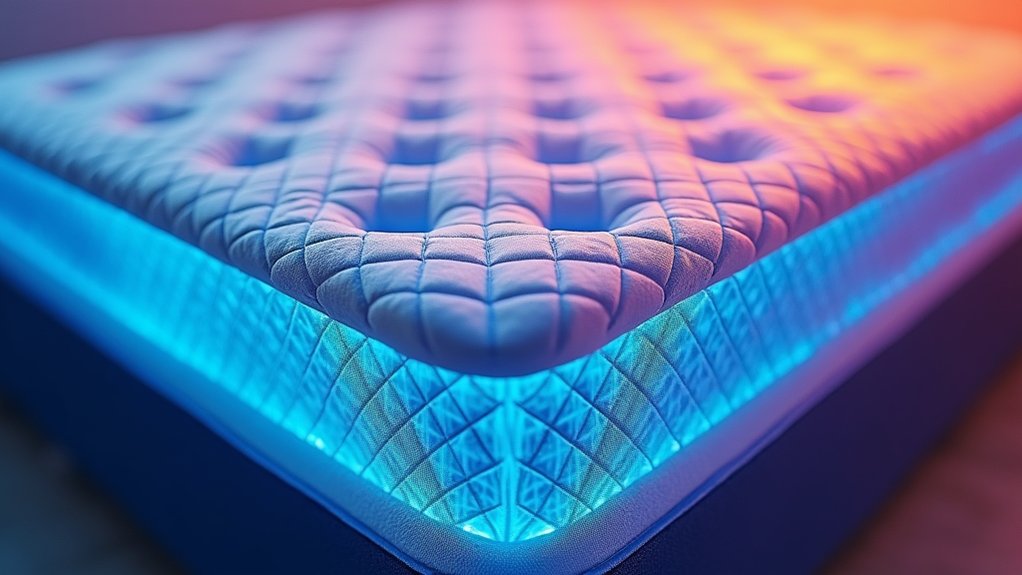
Beyond the support structure of your mattress, temperature regulation can make or break your sleep quality. If you're a side sleeper who tends to run hot, you'll want to focus on mattresses with specific cooling technologies designed to dissipate heat throughout the night.
The DreamCloud's cashmere blend cover provides exceptional breathability and natural temperature control. Hybrid mattresses offer excellent temperature control through their combination of innerspring coils and cooling-enhanced foam layers. The coil structure promotes natural airflow, while gel-infused memory foam helps draw heat away from your body.
You'll find that these designs often include breathable cotton covers or moisture-wicking materials for additional cooling benefits.
For those who prefer all-foam mattresses, look for options with:
- Gel-infused memory foam layers
- Phase change materials that respond to body temperature
- Ventilated or perforated foam designs
- Cooling covers with copper fiber or GlacioTex infusion
Don't overlook edge support when considering cooling features. Strong edge reinforcement prevents excessive sinking, which can lead to heat buildup.
A mattress with proper edge support maintains consistent temperature regulation across the entire surface, especially important when you shift positions throughout the night.
Matching Your Sleeping Style
Finding the perfect mattress match requires understanding how your sleeping position affects your body's pressure points and support needs.
Testing mattresses in person helps determine the most suitable option for your needs.
As a side sleeper, you'll want to focus on mattresses that provide specific firmness levels based on your body weight.
If you weigh under 130 pounds, you should look for mattresses with a firmness rating between 4 and 7, as softer surfaces will better accommodate your pressure points.
For those between 130-230 pounds, target a firmness level of 5 to 7.
If you're over 230 pounds, opt for a firmness rating of 5.5 to 7 or slightly higher.
Your mattress choice should align with your specific sleeping habits:
- If you're a dedicated side sleeper, memory foam or hybrid mattresses will provide ideal pressure relief
- If you switch positions occasionally, consider a hybrid mattress for enhanced responsiveness
- If you sleep near the edge, prioritize models with reinforced edge support
- If you share your bed, look for options with good motion isolation
For maximum comfort, complement your mattress with proper pillow positioning.
Place one between your knees to maintain hip alignment and choose an adjustable pillow that supports your head and neck properly.
Conclusion
As a side sleeper, you'll want to prioritize pressure relief and spinal alignment when selecting your mattress. Studies show that 60% of adults primarily sleep on their side, yet many use mattresses that don't properly support this position. By choosing a medium to medium-soft mattress with memory foam or latex layers, you'll reduce joint pressure and maintain proper alignment. Remember, your perfect mattress should let your shoulders and hips sink while supporting your spine.
